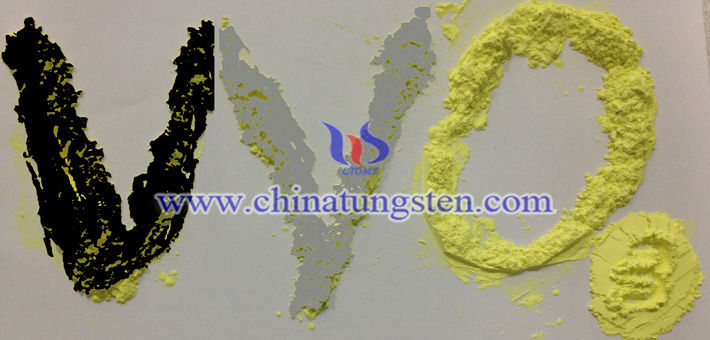A Hydrothermal Synthesis Method of Tungsten Trioxide Photochromic Material
- Details
- Category: Tungsten Information
- Published on Wednesday, 08 August 2018 19:30
Tungsten trioxide is an excellent photochromic material that turns blue under ultraviolet light. So, what is photochromism? Photochromism means that compound A can produce product B with different structure and spectral properties through specific chemical formula when subjected to illumination with wavelength λ1, and B can be reversibly generated under the action of light or heat with wavelength λ2.

The basic characteristics of this process are:
1) A and B can exist stably under certain conditions, and the color parallax is significantly different;
2) The change between A and B is reversible.
The color change of tungsten trioxide is due to the transition of electrons in the W(V) valence band to the W(VII) conduction band. At present, the double charge injection/extraction model proposed in 1975 is widely used to explain photochromism.
The model indicates that after the tungsten trioxide is irradiated by ultraviolet light, the electrons in the valence band are excited into the conduction band, leaving holes in the valence band, and the photogenerated electrons are captured by W(VI) to generate W(V), while the photo-empty A reducing substance inside or on the surface of the oxide film, such as water, generates H+, which is injected into the interior of the film and combined with the reduced oxide to form blue tungsten bronze HxWO3.
In recent years, powders and films have been the main directions for research on the photochromic properties of tungsten trioxide. For example, sodium tungstate is used as a reaction raw material, and a hydrothermal synthesis method is used to obtain a metastable tungsten trioxide having a high stability and a small particle size in a wide pH range (0.5-4.5).
Among them, the tungsten bronze sample synthesized under the condition of pH of about 0.5 was irradiated by a 350 W high-pressure mercury lamp for 10 minutes, and the color changed from light blue to dark blue. When the sample is heated at 95 ° C for 30 min, the dark blue powder will be oxidized by oxygen in the air, returning to the primary color, showing good reversibility. It was confirmed by XPS that a small amount of tungsten (W5+) was present in the hexagonal tungsten trioxide, and the discoloration was caused by the mutual conversion of W5+ and W6+.
In addition, sodium tungstate is used as the tungsten source, hydrochloric acid is used to adjust the pH value, and formaldehyde organically induces hydrothermal synthesis to obtain nanometer tungsten trioxide powder with good dispersibility. Under the irradiation of 3W UV lamp, the color difference of tungsten trioxide powder without formaldehyde is less than 2, and the color difference of formaldehyde-induced tungsten trioxide nanopowder is 20, which shows that the induction of formaldehyde significantly increases the tungsten trioxide powder. Photochromic properties.
According to the analysis, the nanometer size of the tungsten trioxide powder induced by formaldehyde is smaller than the ultraviolet wavelength, and the quantum size effect is remarkable. The electron excited by the tungsten trioxide is more easily converted by the valence band guide band; the larger specific surface area is higher. Reactivity and strong absorption capacity for excitation light.
When the pH is small, the polytungstic acid ion also has a photochromic effect. Therefore, some researchers started from this point of view, choose water-soluble high polymer polyacrylic acid (PAA) as a carrier and film-forming agent, add appropriate amount of glycerol as a moisturizer, prepared Na2WO4-PAA-Glycerol composite film.
After the film is exposed to the sun, the color begins to change after 10s, and becomes the deepest after 10min. When it is dark, it fades to colorless or light blue. The time is less than 2min, showing good discoloration speed and discoloration reversibility.
This is due to the water content in the membrane, which facilitates the diffusion of the electron donor carboxylate, the small molecule oxidation product, and oxygen, and thus the discoloration and fading speed are faster. Based on the experimental results, the researchers speculated that the mechanism of color change originated from the reversible changes of W (V) and W (VI). This fits well with the dual charge injection/extraction model.
In summary, nano-sized tungsten trioxide powder and Na2WO4-PAA-Glycerol composite film have better effects, while tungsten trioxide ultrafine powder has more photochromic conditions (350W high-pressure mercury lamp). This is due to the easier migration of substances during photochromic processes. Material migration involves the transition of electrons, the diffusion of electron donors, oxidation products, and oxidants. Therefore, some researchers believe that one of the directions to improve the photochromic properties of tungsten trioxide is to make material migration easier.
- Tungsten Oxide Manufacturer & Supplier, Chinatungsten Online: www.tungsten-oxide.com
- Tungsten News & Prices of China Tungsten Industry Association: www.ctia.com.cn
- Molybdenum News & Price: news.molybdenum.com.cn
- Tel.: 86 592 5129696; Fax: 86 592 5129797; Email: sales@chinatungsten.com



 sales@chinatungsten.com
sales@chinatungsten.com